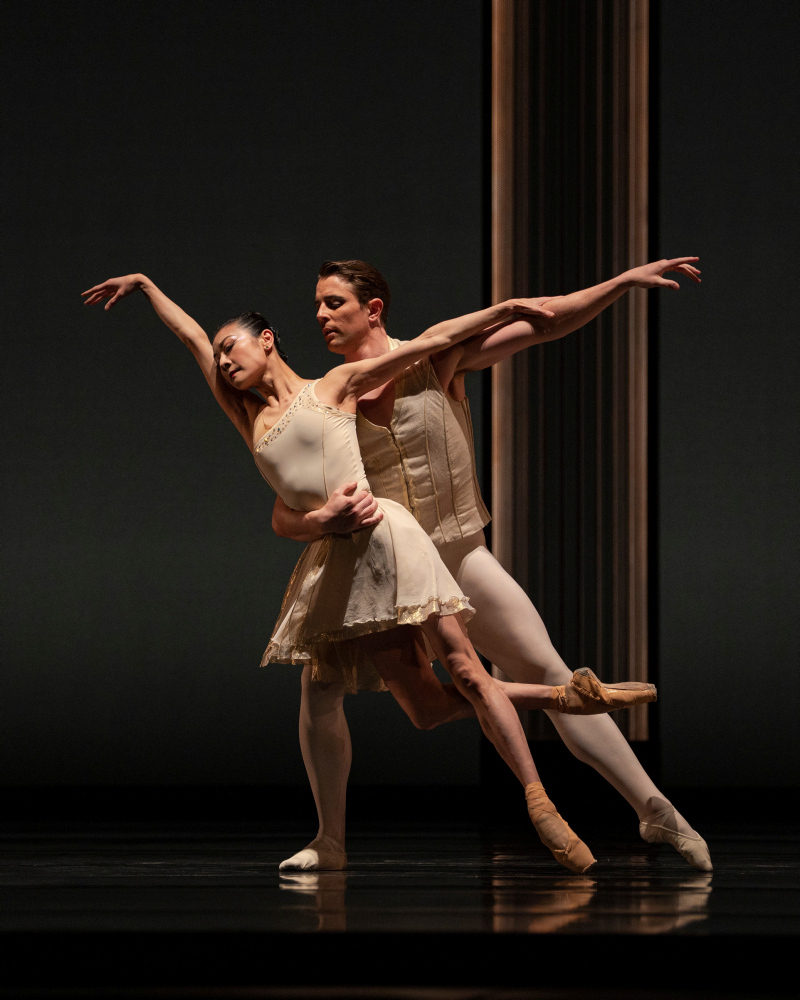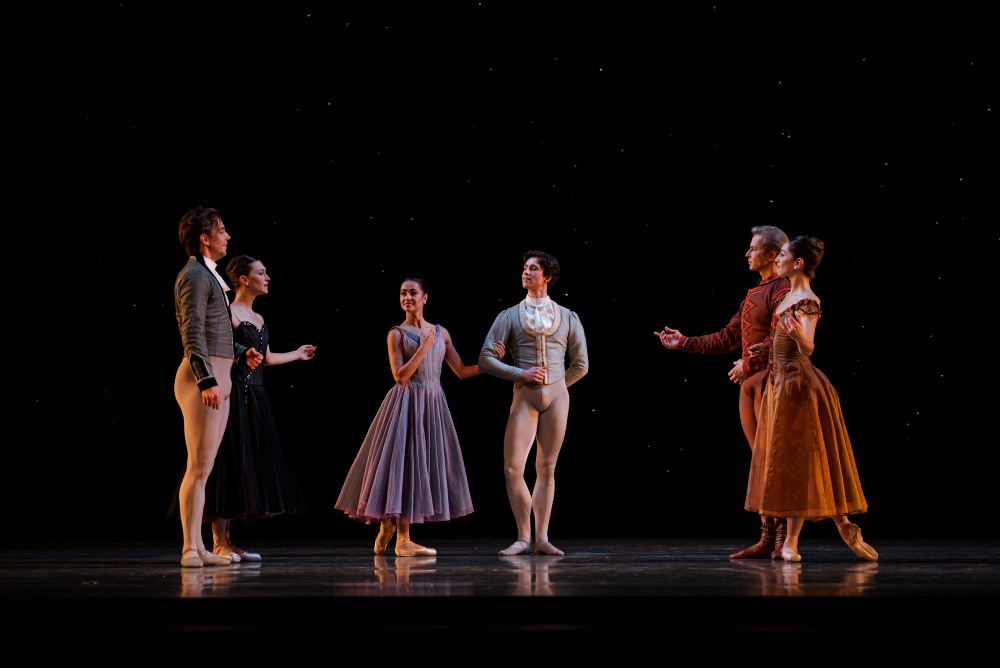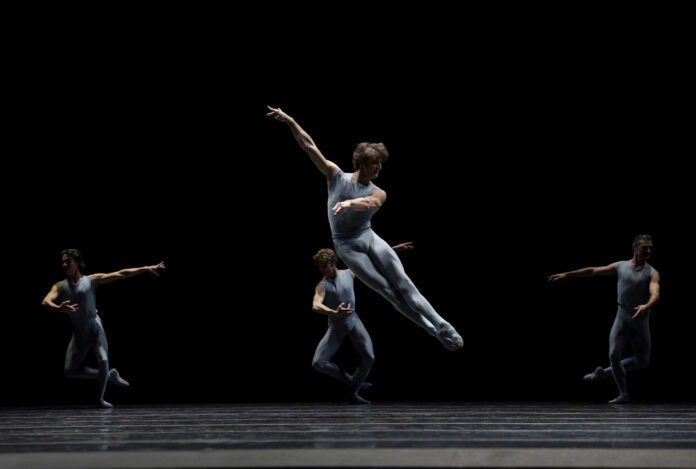A desire to show us how easily the flexibility of ballet’s venerable language can find its place in contemporary art might have inspired Helgi Tómasson’s last season as artistic director and principle choreographer of San Francisco Ballet. The three pieces he chose for the second program of his going-away, performed February 3-13, included his own “Caprice” from 2014 and Jerome Robbins’ “In the Night,” choreographed in 1970 for the New York City Ballet (much to Balanchine’s dismay). But the local premiere of “Blake Works” by William Forsythe crowned this evening with intriguing ideas, excellently performed.
Forsythe is the American choreographer who in the 1980s bolted for Germany, where many of us thought him lost to ballet. But there he expanded his repertoire to include language, visual arts, music, and theater, submitting and deconstructing each to their formal bones. The resulting works—intricate, complex, sometimes irritating or overwhelming, have made him one of the most important living choreographers. They speak to the brain as well as to the heart. You never walked away without the realization that whatever you saw had merit.
So maybe it made sense for Forsythe, in what some have called “a love letter to ballet” to create the 2016 “Blake Works” for the Paris Opera Ballet, one of the foremost classical ballet companies in the world.
The half-hour “Blake Works” is set on seven excerpts from emotive British electronic pop star James Blake’s song cycle “The Colour in Anything.” Blake keeps vocals at the distance, and there were times when I wished to see how the choreography arose, not only in the music but in the lyrics. It seems only fair that if you use text, we should have access to it. Still “Blake Works” is an astoundingly complex choreography in which Forsythe slices and re-assembles overlapping groups, from which small units might emerge. A pulsating but non-intrusive beat suggests a club scene. Everyone is dressed light blue except for, at one point, Joseph Walsh who is in black while strenuously partnering a tough Julia Rowe.

The spirit of “Blake Works” is joyful with a great sense of play about it. I have rarely seen the company so clearly enjoying its tasks. But there is nothing spontaneous about this “romp.” The work is highly structured with, for instance, different ensembles, perhaps competing for space, but stacked on top of each other like layers on a cake. Changes are so fast that the eye can hardly follow. Verticality and speed dominated. Arms—those genteel port de bras of classical ballet get their own shooting, curling, folding moment with thrusts.
In the opening moments, shoulder-level arms stretched into a wall that collapsed into bobbing hips and teasing épaulements. Sasha De Sola and Rowe started out by peeling out of the ensemble. For the finale a grinning De Sola gave us an evaluation of this delicious gift. Emerging from the group she casually ambled downstage. Her body said it all: “What fun this was”.
Program II opened with an homage to ballet. Traditionally the pas de deux, always a male-female duet, is classical ballet’s high point. Intricately demanding choreography celebrates a love relationship, sometimes a wedding. With his 2014 non-narrative “Caprice,” set to a symphonic work by Camille Saint-Saens, Tómasson lovingly made the pas de deux the subject of his choreography.

First Angelo Greco partnered fleet Misa Kuranaga in a series of quick lifts and buoyant turns, until all of sudden he slid her along the floor as if on ice. A small corps in the background doubled this duet as if paying homage to the dancers. The second movement could not have been more different. Luke Ingham partnered with the singular Yuan Yuan Tan, who joined the company in 1995 and still is a wonder to behold, as she opened, stretched, and folded her remarkable limbs, reaching beyond what seemed reasonable.
No wonder Tómasson gave Ingham three other men (Hansuke Yamamoto, Steven Morse, and Henry Sidford) to expand Tan’s lyrical potential. The third movement brought the two couples together, highlighting Tan and Kuranaga’s similarities and differences. The concept for this ballet may have been simple but the clarity and musicality with which Tomasson realized it made a little jewel of neo-classical dance.

Program II also featured “In the Night,” which must be one of Robbins’ most popular works. Set against a star-filled sky, and a number of Chopin nocturnes, three couples explore their relationship. They have stories to tell, not really spelled out, but certainly suggesting experiencing love one way or another. Mathilde Froustey and Benjamin Freemantle are the young people caught in a whirlwind relationship that them sends in and out of each other’s arms. Fremantle’s lifts and Froustey whipping turns seems run away with themselves. As they stroll out, both seem caught in a dream.
The stiff-necked formality with which Jennifer Stahl and Tiit Helimets stalk in speaks of familiarity but not closeness. Maybe their relationship has hardened but habit is the chain that holds them together. An even more painful relationship was that between a furiously lashing out Sarah Van Patten and her patiently suffering Ulrik Birkkjaern. They grab each other and reach for physical closeness that borders violence. But both leave the stage arm-in-arm. Robbins adds an almost cynical finale when the partners return and exchange pleasantries. It made you wonder what Robbins thought of social intercourse.





